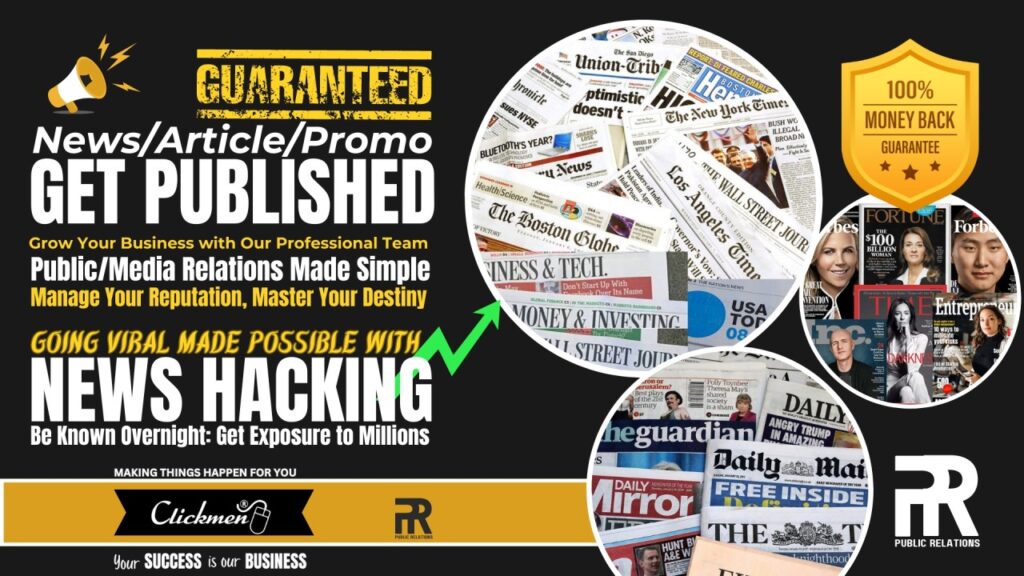In today’s fast-paced digital world, having a robust media presence is more crucial than ever. Whether you’re a startup looking to make a splash, an established business aiming to maintain relevance, or a thought leader seeking to amplify your voice, getting featured in the media can significantly enhance your brand’s visibility and credibility. However, securing press coverage can be a challenging and unpredictable process. Enter Clickmen™, the #1 Public Relations (PR) agency in the United States, offering guaranteed global press/media coverage with an unmatched 100% money-back guarantee.
In the contemporary business landscape, the lines between public relations (PR), marketing, and advertising are increasingly blurred. Traditionally, these disciplines operated in silos, each with its distinct goals and methodologies. However, integrating PR with marketing and advertising is proving to be a powerful strategy, driving brand visibility, credibility, and consumer engagement to new heights. This holistic approach leverages the strengths of each discipline, creating a synergistic effect that enhances overall brand performance.
PR focuses on building and maintaining a positive image and fostering good relationships with the public. It involves managing communications between an organization and its audience, which includes customers, investors, media, and the community. Marketing, on the other hand, aims to understand customer needs and create value, while advertising involves paid promotions to reach and persuade potential customers. By integrating PR with marketing and advertising, brands can ensure consistent messaging, maximize reach, and build trust more effectively.
One of the key benefits of this integration is enhanced credibility. PR efforts, such as media coverage, influencer partnerships, and thought leadership, can lend authenticity to marketing and advertising campaigns. Consumers are more likely to trust and engage with brands that are endorsed by credible third parties. For instance, when a product launch is supported by positive media reviews and influencer endorsements, the subsequent marketing and advertising campaigns are more likely to resonate with the target audience and drive sales.
A real-life example of successful integration can be seen in the case of Dove’s “Real Beauty” campaign. Dove combined PR, marketing, and advertising to challenge traditional beauty standards and promote body positivity. The campaign began with PR efforts to highlight the issue, including partnerships with activists and coverage in influential media outlets. This was followed by a series of powerful advertisements featuring real women of diverse shapes, sizes, and ethnicities. The marketing efforts included social media engagement and community-building activities, reinforcing the message of inclusivity and authenticity. This integrated approach not only boosted Dove’s brand image but also significantly increased sales and customer loyalty.
Another notable example is Coca-Cola’s “Share a Coke” campaign. The campaign started with a PR strategy aimed at creating a buzz around personalized Coke bottles. Coca-Cola engaged media outlets and influencers to spread the word, generating anticipation and excitement. The marketing team then rolled out the campaign with a strong social media presence, encouraging consumers to find bottles with their names and share their experiences online. Advertising efforts included TV commercials and outdoor ads, creating a cohesive and engaging narrative. The integration of PR, marketing, and advertising helped Coca-Cola connect with consumers on a personal level, resulting in a significant increase in sales and brand engagement.
Integrating PR with marketing and advertising also enhances crisis management capabilities. In times of crisis, a unified communication strategy is crucial to manage public perception and mitigate potential damage. For instance, when Toyota faced a massive recall crisis due to faulty airbags, their integrated approach helped manage the situation effectively. The PR team worked on transparent communication with the media and the public, while the marketing team focused on reassuring customers through targeted advertisements and direct communication channels. This coordinated effort helped Toyota regain consumer trust and stabilize their market position.
Integrating PR with marketing and advertising is not without its challenges. It requires seamless coordination and communication among different teams and a unified strategy that aligns with the brand’s overall objectives. However, the potential benefits far outweigh the challenges. Brands that successfully integrate these disciplines can create more impactful campaigns, build stronger relationships with their audience, and achieve sustainable growth.
Furthermore, Public Relations (PR) and media coverage play a crucial role in enhancing SEO efforts by creating high-quality backlinks, increasing brand visibility, and generating organic traffic. When reputable media outlets and influencers feature your brand, it results in backlinks from authoritative websites, which are a key factor in Google’s ranking algorithm. These backlinks signal to search engines that your content is valuable and trustworthy, improving your website’s search engine rankings. Additionally, media coverage can drive a surge in organic traffic as more people become aware of your brand and search for it online. This increased visibility not only boosts direct traffic but also enhances social signals, further reinforcing your SEO strategy. By integrating PR with SEO, you create a synergistic effect that amplifies your online presence and credibility.
In conclusion, the integration of PR with marketing and advertising is a winning combination in today’s dynamic and competitive market. By leveraging the strengths of each discipline, brands can enhance their credibility, maximize their reach, and foster deeper connections with their audience. Real-life examples like Dove and Coca-Cola demonstrate the power of this integrated approach, offering valuable lessons for brands looking to elevate their strategies and achieve lasting success.

